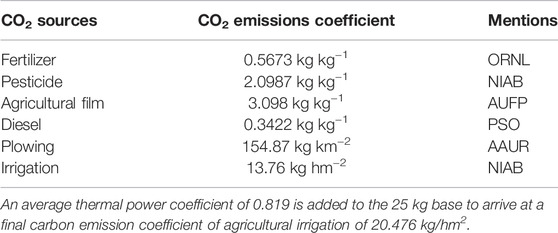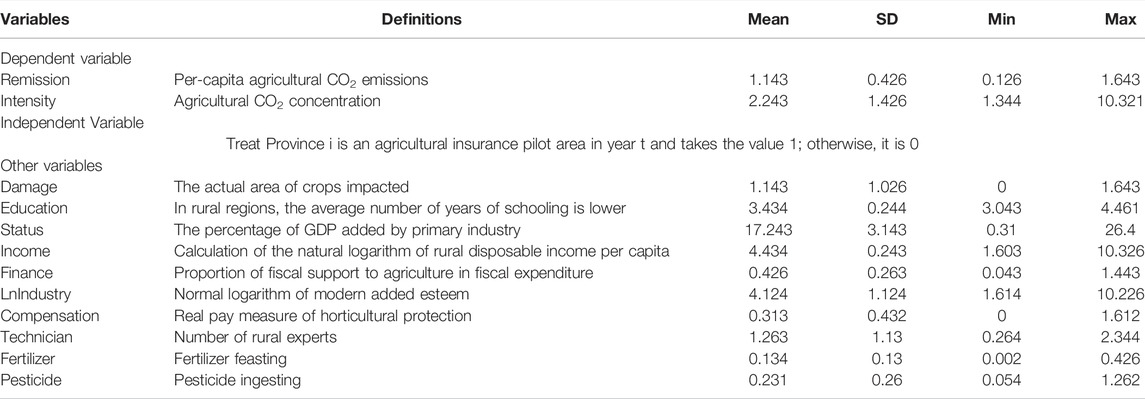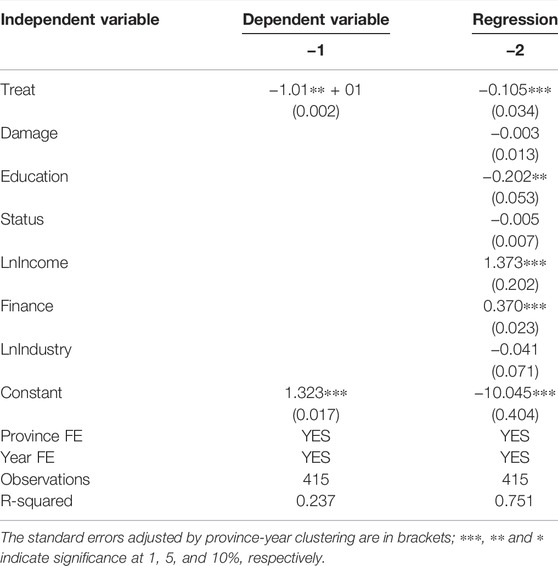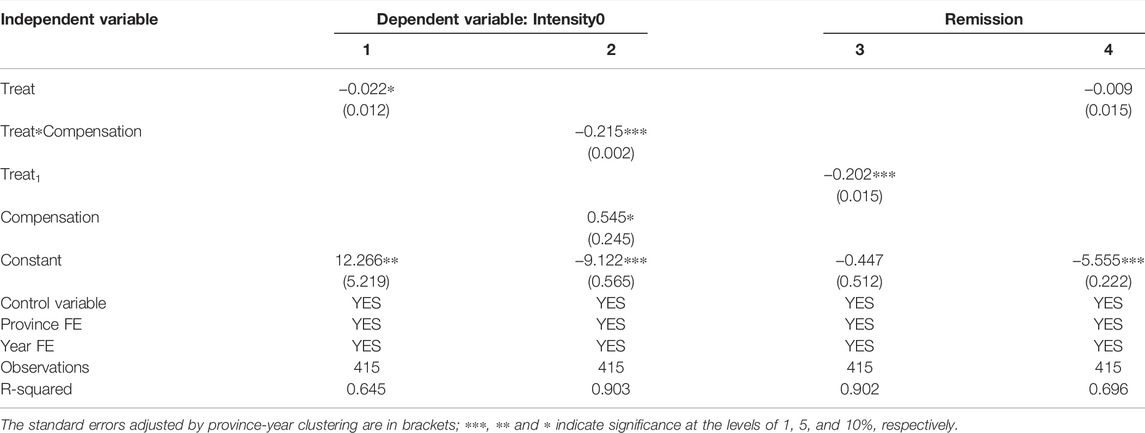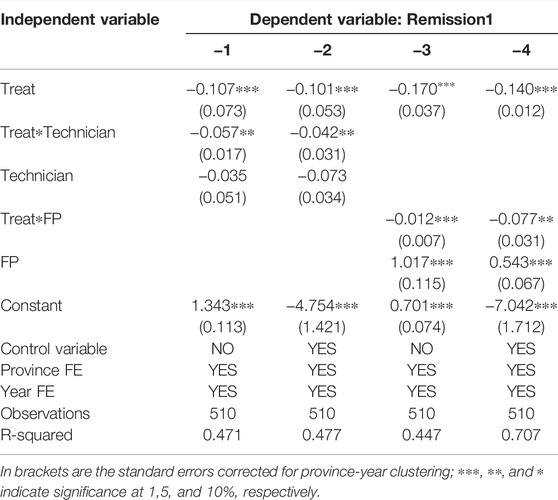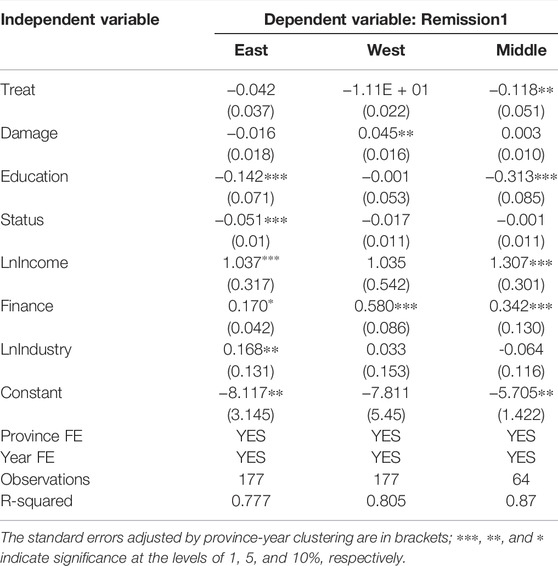- School of Economics, Tianjin University of Commerce, Tianjin, China
To achieve its extraordinary goal of attaining the top carbon level in 2025 and eliminating carbon bias by 2045, Pakistan needs to focus on reducing carbon emissions in rural areas. Insurance for farmers is seen as a viable risk management and insurance strategy that might help spread the risk of agricultural activities and promote green rural development. In the present study, a multistage dynamic verified model was conducted from 2000 to 2019 in Pakistan, to assess the influence of a strategy of planned rural protection on green horticulture outcomes, fundamentally to characterize the unique impact system. The results indicate that rural fossil fuel byproducts are rising steadily, and implementing an agricultural protection plan significantly reduce these byproducts. In addition, this research provides practical ideas for a low-carbon rural turn of events and the formulation of vital macroeconomic horticulture techniques. It confirms the positive outcomes for strategically located agricultural insurance, and provides critical contract suggestions for reducing rural fossil fuel byproducts, and controlling initiatives in Pakistan and other countries.
1 Introduction
There is a consensus that the accumulation of ozone-depleting substance (GHG) releases is the primary cause of the environmental changes that are taking place (Sun et al., 2022a; Sun et al., 2022b). Pesticides and economic growth substantially impact carbon emissions in Pakistan, but short-term data show that economic expansion has a beneficial impact on carbon emissions. Pakistan significantly impacts, and is affected by, global environmental change since it is a growing, developing economy, with an enormous population of 22 billion and the lowest score (33.1/100) in the overall environmental performance index, standing at 142 ranks globally. In response to the current ecological crisis, low-carbon horticulture management can be used as an optimal tool. A low-carbon development strategy is required for emerging nations to retain their overall economic production, while emitting less carbon dioxide (Duan et al., 2020). State-run governments worldwide spend billions of dollars on farm subsidies, and international efforts have invested vital resources in horticulture protection. Agricultural carbon emissions are an essential metric for assessing the ecological impact of agriculture. As a result of numerous catastrophes, POAI was instituted. POAI refers to the direct physical and compound expenditure insurance provided by the public authority as a form of contract support (Sun and Razzaq, 2022). For soil erosion and water quality, as well as broader soil health, cover crops and decreased tillage (referred to as conservation tillage) are suggested (Gardezi and Arbuckle, 2019). Protecting horticulture is expected to have a positive effect on agricultural productivity in both rural and low-carbon contexts. Ranchers’ interest in new ventures, compound speculation, and the farming climate are all affected by mortal danger and antagonistic choice within the agricultural protection framework. The execution of a strategy is evaluated by comparing the differences in independent variables between the trial group and the benchmark group when such arrangements are put into practice . In line with the multistage dynamic difference-in-difference (DIDs) model, the present study explores the influence of a strategy of planned rural protection on outcomes in green horticulture in Pakistan.
The remainder of this article is structured as follows: Section 2 presents relevant literature and hypotheses, Section 3 outlines study data and methdology, while results and discussion are presented in Sections 4 and 5. Finally, Section 6details conclusions and recommendations.
2 Literature Review
When it comes to agricultural media coverage of crop insurance and cover crop use, many stories focus on farmers who could not meet crop insurance criteria while growing cover crops, and so decided to quit using crop insurance altogether (Sun et al., 2022b). The dual hazards of agriculture can be alleviated by agricultural insurance, which can help farmers better withstand risks by using green technology and reducing agricultural carbon emissions. Pesticide usage in Pakistan increased from 14,848 metric tons per year in 1987 to 78,132 metric tons per year in 2003, according to Syed and Malik (2011). According to the statistics, about 206,730 metric tons of pesticides were used in Pakistan in 2017 as a result of this rise in consumption (GOP 2017). Crop insurance might help reduce agricultural carbon emissions, but chemical inputs are a significant source of those emissions. According to the latest statistics, pesticides are used in Punjab Province, Sindh Province, Khyber Pakhtunkhwa Province, and Baluchistan Province. Even though Pakistan’s Agricultural Pesticide Ordinance of 1971 provides clear guidelines for the prudent use of pesticides, many farmers still fail to follow them (PARC 2018). Generally, Pakistani farmers do not follow the required chemical measures for managing dangerous pests and weeds in their crops (Tariq et al., 2007). Agricultural non-point source pollution prevention strategies include source reduction, transmission process blocking and interception, nutrient recycling and water body ecological restoration, all of which fall into four broad categories. Green agriculture and the shift from high-carbon, widespread agriculture development to green, intensive agricultural development are both effective ways to increase agriculture’s long-term sustainability. There are several advantages to exchanging point sources for non-point sources to regulate agricultural non-point sources and gain additional emissions permits (Sun et al., 2022c). However, according to Leblois et al. (2014), agricultural weather index-based insurance can help alleviate some of the problems of traditional insurance, such as asymmetric information and high transaction costs, and transfer the risk of weather disasters to insurance companies, which is essential for the promotion of index-based insurance. Insuring farmers’ income, enhancing farmers’ ability to withstand risk through agricultural protection facilities, and encouraging farmers to use environmental protection equipment all contribute to reducing agricultural carbon emissions (Gunnsteinsson 2020; Sun et al., 2022c). Only three nations—Pakistan, India, and the United States—collectively pay about $18 billion each year on government insurance subsidies. It may encourage farmers to take on too much risk, such as planting inappropriate crops in unsafe areas or growing more of them, which may increase future costs of insurance to the government, and may harm the environment as a result. Traditional crop insurance policies can benefit from the findings of this study, as can innovative solutions that reduce base risk while addressing the issues associated with asymmetrical knowledge. As a second objective, this article connects the research on insurance in developing countries with the more general literature on trust in organizations. Asymmetric information has been studied in recent years using a dynamic data, (DID) approach, direct data on subjective beliefs, and structural estimates (Finkelstein et al., 2005). By controlling excess field moisture and preserving organic matter, conservation methods can help reduce some of the harmful effects of climate change (Gardezi and Arbuckle, 2019). When it comes to agricultural media coverage of crop insurance and cover crop use, many stories focus on farmers who could not meet crop insurance criteria while growing cover crops and decided to quit using crop insurance altogether. The farmers’ primary goal is to minimize risks and maximize income. Producers may lose coverage if they implement a conservation strategy that reduces the insured crop’s production. Producers need to ensure, in any way possible, that their methods do not hinder the maturity of the insured crop. Most of the agricultural carbon emissions arise from the excessive use of agricultural chemicals, which are directly linked to the farming environment.
3 Research Methodology
3.1 Difference-In-Differences Model
Pakistan’s POAI plan begins with an experimental run program, and the pilot time varies in different areas of Pakistan. With these goals in mind, the study used the DID method to examine the effects of horticulture insurance contracts on farmed fossil fuel byproduct levels in a semi-regular experiment. The following models can be used to evaluate the POAI strategy’s impact:
Xit refers to the reliant variable, which is the agricultural fossil fuel byproduct level of area i in t, where i refers to the territory and t refers to the year. To determine the quantity of farm-produced fossil fuel byproducts, our study examined per-capita fossil fuel byproducts (Decline). Xit, on the other hand, addresses several control factors at the common level(discussed further below), while Treatit addresses the study’s central free factor (the POAI strategy). For the year, Treatit has a value of 1 and a value of 0 in all other circumstances. The use of an arbitrary pejorative is regrettable
3.2 Selection of Variables
The study draws on the after-effects of IPCC and the exploration consequences of ancestors to compute horticultural fossil fuel byproduct levels, and uses per-capita fossil fuel byproducts as a reliable variable to gauge natural contamination from rural creation and cultivation. The computation strategy is displayed in Conditions 2–4, and the carbon source coefficient is expressed in Table 1.
For Condition 2, Emissioni refers to the entire farmed fossil fuel byproduct in area I whereas Fsi refers to different carbon sources’ absolute fossil fuel byproduct in area i. Use of fossil fuel byproduct sources in region i is the carbon emission source’s fossil fuel byproduct coefficient. Per-capita farming fossil fuel byproduct of area i is addressed by (Remissioni) in Condition 3, where TRPi refers to the whole provincial population of territory i. Strength analysis below picks agricultural fossil fuel byproduct power as an example of a heavily dependent variable. As shown in Condition 4, the horticulture carbon emission power (total agricultural fossil fuel byproducts divided by agrarian added value) of area I is represented by CIOAi while the additional agricultural worth of region (agrarian) is represented as AAVi. Uses rural financial use and all-out spending to determine how neighboring states support agriculture. Local green space creation will see positive outcomes and progress if neighboring states give greater thought to horticulture. Due to the fact that horticulture innovation and rural hardware creation levels are linked to the refreshing speed of modern development and determine the progress of green agrarian creation afterward, this study also controls the added value of an industry.
3.3 Data Collection
This study used panel data from 415 perspectives in 24 locations from 2000 to 2019 to investigate rural protection’s real influence and internal component on horticulture fossil fuel byproducts. The data on farming insurance payments and agricultural subsidies were obtained from the Pakistan Bureau of Statistics, the Government of Pakistan and the Pakistan Agriculture and Dairy Farmers Associations, while control variables were gathered from the World Bank database. A detailed definition and description of variables are presented in Table 2.
We used Stata (Version 15.0) in this study to conduct analyses. The measurable tests are two-sided, and the p-esteem indicates if the outcome is genuinely critical. p upsides of <0.1 (*), <0.05 (**) and <0.01 (***) are thought of as genuinely critical.
4 Results
4.1 Examination of POAI on Agrarian Fossil Fuel by Product Power
In this study, a multistage dynamic model was used to analyze the impact of provincial insurance pilot policies on agrarian non-renewable energy sources. Without controlling variables, Section 1 of Table 3 presents the veritable effect of agrarian assurance on the per-capita rustic non-renewable energy source.
Further, after the circumstance controls the disaster area, guidance level, provincial assistance level, cultivating status, and various components, the coefficient sign of the Treat variable (twofold phony variable of agrarian insurance pilot) in Model 2 of Table 3 is still significantly negative, confirming that the policy intervention has moderate decreases per-capita agricultural petroleum derivative. According to the outcome of the Treat coefficient, when various variables stay unaltered, the per-capita rural non-renewable energy source side-effects of pilot domains are decreased and center on typical differentiated and non-pilot locations, which is colossal at the level of 1%. Along these lines, the specific results attest that Pakistan’s continuous plant insurance policy plays a role in mitigating non-renewable energy source side-effects. With the coefficients of the control factors, it is observed that the coefficient of farmers’ run-of-the-mill extensive stretches of preparation (Tutoring) is negative and substantial at the 5% level, showing that the higher the tutoring level of farmers, the more significant effect of mitigating agricultural petroleum derivative. Meanwhile, the coefficients of agricultural disaster degree, provincial outcome regarding extent (Status), and present-day added regard (Industry) are negative, showing that the more certified the cultivating disaster degree, the higher the circumstance with agribusiness or the higher the level of current development, the lower the level of agricultural petroleum product. Besides, the coefficient of farmers’ per-capita optional income (Pay) and financial assistance to agribusiness (Cash) are positively associated, certifying that the development in farmers’ compensation and cultivating assistance will increase the levels of agricultural petroleum derivative.
4.2 Robustness Analysis: Parallel Trend and Placebo Test
4.2.1 Parallel Trend Test
The parallel trend test effectively analyzes the real effects of strategy-based rural protection experimental run programs on agricultural fossil fuel byproducts. This technique is significant in analyzing whether there is a significant difference in agrarian fossil fuel by-product levels between the pilot and non-pilot groups, and without a trace of the rural protection pilot’s external influence. In line with equal pattern test approach, the present study adopts the following bidirectional fixed impact model:
In Condition 4, Treat−7 is the twofold false factor taking into account the pilot time of typical techniques. At the point when the locale is in the
4.2.2 Placebo Treatment Test
This research uses Cai et al.’s (2016) approach for fake treatment testing to construct “pseudo-arrangement faker variables” by hastily designating preliminary time to ensure that the above exact ends are not influenced by ordinary elements. From 2007 to 2012, the pilot season of agricultural insurance in 30 territories was randomly picked to manufacture “pseudo contract fake factors” and 1,000 irregular examples and rehashed relapse several times as suggested by Condition 1. The x-hub alludes to the amount of the “pseudo-approach fake variable” coefficient gauge, the y-hub is the part thickness esteem, and the p-esteem is the blue speck.
4.2.3 Robustness Tests
This section includes a variety of tests designed to ensure that the observational endpoints are also credible. Most fundamentally, agricultural fossil fuel byproduct force is used as an intermediary variable of rural fossil fuel byproduct level rather than per-capita fossil fuel byproduct in Segment 1 of Table 4. Despite removing the autonomous center variable, the result indicated that the Treat gauge remained entirely negative, confirming the carbon reduction benefit of agricultural protection. Furthermore, in Qain and Nunn (2011) “semi multiplier technique,” the genuine horticultural protection remuneration measure is replaced by the pilot faker variable to quantify the execution power of protection sponsorships and the collaboration between the real agrarian protection pay measure and the virtual variable is added to the relapse.
As shown in Section 2 of Table 4, the communication coefficient is significant, indicating that fossil fuel byproducts per capita are dropping while protection benefits continue to rise. Finally, Segment 3 of Table 4 outlines a counterfactual experiment shifting the location of the approach. After randomly implementing the POAI strategy a year ahead of schedule, it was discovered that the assessment aftereffect of the center autonomous variable coefficient was not critical, indicating that the horticultural protection pilot’s development did not have a fossil fuel byproduct reduction impact. Finally, due to the issue of missing components, all control factors were one period behind. Rural protection continues to cripple agricultural fossil fuel byproducts, as seen in Segment 4 of Table 4. In contrast to Segment 2 of Table 1, the Treat and endorsed at the 1% level, confirming the pattern’s power. In summary, the power tests provide sufficient observational support for Hypothesis 1.
4.3 POAI Instrument Testing for Reducing Horticulture Carbon Emissions
Ranchers’ reactions to new agrarian innovations are heavily influenced by their wealth and risk aversion. In contrast, agricultural protection plays a significant role in dispersing risks and balancing out the supply of assets. Protected farmers are more likely to update agricultural innovations and embrace environmentally friendly and skilled equipment, thereby increasing interest in rural specialized abilities. As mentors in rural development, farming professionals advise safe farmers to embrace cooperative improvements that might help reduce rural fossil fuel byproducts. This section uses cross-econometric models to investigate the beneficial effect of horticulture protection on agrarian carbon discharges due to agricultural exports.
The assessed coefficient of the number of farming professionals (Professional) is negative and significant, regardless of whether other factors are controlled, and the coefficient of Treat*Technician is also negative, demonstrating that POAI can reduce per-capita farming fossil fuel byproducts by increasing the number of horticultural professionals, explaining the mechanism’s viability1. Second, in Table 5, Sections 3 and 4 show the relapse implications of Component 2. We discovered that whether or not different factors were controlled, the assessed coefficient of FP was fundamentally positive, and the Treat *FP coefficient was fundamentally negative, demonstrating that POAI reduced farming fossil fuel byproducts by reducing pesticide and manure utilization and endorsing preposition 2.
4.3.1 Heterogeneity Investigation: Contrasts in the Eastern, Focal and Western Areas
The moderation impact of rural protection on agricultural fossil fuel byproducts has been exhibited previously. Because of diverse contrasts in institutional circumstances and protection execution among regions, we theorized that this impact might be spatially heterogeneous. The fundamental assessments are displayed in Table 6, where the Treat gauge for the eastern and western areas are insignificant, while the carbon decrease impact of the relating horticultural protection in Central locations is substantially negative at the 5% level.
Simultaneously, the negative coefficients in Sections 2 and 3 of Table 6 show that the rural insurance contract decreases the per-capita rural fossil fuel byproducts focal Pakistan individually, and the impact is for sure more clear than that in the eastern location. Through the above bunch test, it is affirmed that there is a heterogeneous spatial impact of the horticultural insurance contract.
5 Discussion
Pakistan has had the most consecutive horticultural disasters and misfortunes. Notably during the 1990s, the frequency of disasters and the magnitude of casualties increased. Unfortunately, due to credit restrictions (Mehmood et al., 2018) and knowledge asymmetry concerning health insurance, health insurance in Pakistan is not widely available. The accelerated implementation of POAI in Pakistan has significantly improved Pakistani farming’s risk mitigation capabilities, widening horticulture threats, stabilizing the horticultural market, and speeding up present farming growth. As noted in the 2019 IPCC Extraordinary Report on Environmental Change and Land, ozone-depleting substance outflows from horticultural exercises totaled 10.8 to 19.1 billion tons of emissions between 2007 and 2016, comprising 21–37% of worldwide ozone-depleting substance emanations. Therefore, green agricultural transformation is the only solution to minimize the ecological footprints of the agriculture sector. This study applied multistage dynamic DID to investigate the environmental impacts of horticultural protection. This uniqueness might be brought about by moral peril and unfavorable choice, reinforcing the replacement connection between protection and component input, empowering farmers to utilize input the increment risk and diminish inputs/risks to exert a specific influence on the farmland climate. Although POAI strategies can be compelling in reducing carbon power, the primary systems should be explained. Khan and Khan et al. (2021) confirmed with study information from eight areas in Pakistan that rural protection essentially debilitates pesticide use force, which is consistent with our findings. Second, the increment of specialized horticultural faculty can more readily direct farmers to use proficient and safe manures, low-harmfulness and low-buildup pesticides, green creation advancements, and successfully reduce farming fossil fuel byproducts. In contrast, In contrast, uninsured farmers and protected farmers are more disposed to change their horticultural creation conduct, which is from the agrarian protection. Maguire-Rajpaul et al. (2016) affirmed that agricultural protection can improve the capacity of farmers who took on natural security innovation and advance green horticultural creation. Likewise, considering the attributes of protection plans and the extraordinary contrasts in rural gamble levels in various areas, the widespread impacts of yield protection will normally fluctuate enormously. The present study confirmed speculation 3 through heterogeneity investigation and power examination. Results of the spatial heterogeneity investigation show that the impact of the carbon decrease of agricultural protection in eastern Pakistan is not on par with that in central and western Pakistan. The reason for this outcome might be that the western and central locations are overwhelmed by substantial horticultural territories. Furthermore, the advancement of rural protection in these locales has essentially advanced horticultural gamble obstruction, subsequently speeding the rate of rural natural assurance innovation, and significantly decreasing in substance utilization. Overall, results affirmed that the relief impact of horticultural protection on fossil fuel byproducts expanded step by step, justifying the need for extensive execution of the approach.
6 Conclusion
Changing the conventional horticultural creation method of independence and expanding activity to the green and serious current agrarian creation mode is an inescapable pattern of farming activity. It is also unavoidable in order to develop further rural creation effectiveness and the intensity of rural item advertisements. Using adjusted board information from 24 areas in Pakistan from 2000 to 2019, this study utilized a multistage dynamic verified to investigate the “net impact” of POAI on rural fossil fuel byproducts. The study, most importantly, found that rural protection can successfully check horticultural fossil fuel byproducts, and fossil fuel byproduct force of the execution areas diminished, which has incredible importance for guaranteeing ranchers’ pay, making farming more efficient, acknowledging supportable agrarian outcomes, and enhancing green rural economy. Furthermore, the restraining impact of farming protection on horticultural fossil fuel byproducts occurs because of the significant decrease of pesticide and compost inputs and the increment of agrarian specialized staff. The results confirmed that farming insurance contracts lead to carbon decreases in central and western territories, demonstrating the need to develop individualized horticultural protection contracts. This article presents the results of strategy-situated horticultural insurance, offering a reference for the public authority to advance the current farming protection sponsorship framework through developing a contract direction component for national ecological security. Accordingly, we propose best practice rules for enhancing the plan and execution of horticultural protection, adding a green sponsorship component to help the advancement of low-carbon farming and improvement of agribusiness. Thus, public authorities would allow the execution of horticultural insurance, continually work on supporting contracts and measures for rural protection, speed up the extension of farming protection inclusion, and give full play to the job of agricultural protection as a stabilizer and supporter in current green agrarian creation. Second, policymakers should upgrade the current rural insurance sponsorship framework, focus on building a low-carbon green appropriation instrument and supporting measures, and execute individual endowment contracts for various harvests and/or creation modes. For instance, more appropriations should be given to low-carbon and harmless ecosystem creation techniques, which will assist with increasing food security and improving horticultural climate. Third, the public authority should execute a province-specific farming sponsorship framework, increment strategy inclination for the central and western districts, and change the emphasis of horticultural protection from “safeguarding creation costs” to “safeguarding grain yield” and “safeguarding neighborhood attributes”. Fourth, the public authority needs to normalize horticultural protection regulation, set flexible farming protection appropriation proportions as circumstances dictate, explain the fiasco distinguishing proof pay instrument, and direction the utilization of protection charge. To summarize, rural protection is an irreplaceable and powerful device to enable modern green farming. This study detailed the effect of farming protection on horticultural fossil fuel byproducts and its inner components, which supports recent evidence of green rural creation and gives a dependable reference to the incorporated advancement of money and agribusiness and policymaking.
Data Availability Statement
The original contributions presented in the study are included in the article/Supplementary Material, and further inquiries can be directed to the corresponding authors.
Author Contributions
YS: conceptualizing, writing, drafting-original draft; WG: data and methodology; YL: conceptualizing, writing, drafting-original draft; TQ: conceptualizing, writing, drafting.
Conflict of Interest
The authors declare that the research was conducted in the absence of any commercial or financial relationships that could be construed as a potential conflict of interest.
Publisher’s Note
All claims expressed in this article are solely those of the authors and do not necessarily represent those of their affiliated organizations, or those of the publisher, the editors and the reviewers. Any product that may be evaluated in this article, or claim that may be made by its manufacturer, is not guaranteed or endorsed by the publisher.
Acknowledgments
The authors thank the financial support from the National Statistical Science Research Project (2022LY067).
References
Cai, X., Lu, Y., Wu, M., and Yu, L. (2016). Does Environmental Regulation Drive Away Inbound Foreign Direct Investment? Evidence from a Quasi-Natural Experiment in China. J. Dev. Econ. 123, 73–85. doi:10.1016/j.jdeveco.2016.08.003
Duan, Z., Wang, X., Dong, X., Duan, H., and Song, J. (2020). Peaking Industrial Energy-Related CO2 Emissions in Typical Transformation Region: Paths and Mechanism. Sustainability 12 (3), 791. doi:10.3390/su12030791
Finkelstein, Amy, McGarry, K., and Sufi, A. (2005). Dynamic Inefficiencies in Insurance Markets: Evidence from Long-Term Care Insurance. Am. Econ. Rev. 95 (2), 224–228. doi:10.1257/000282805774669808
Gardezi, M., and Arbuckle, J. G. (2019). Spatially Representing Vulnerability to Extreme Rain Events Using Midwestern Farmers' Objective and Perceived Attributes of Adaptive Capacity. Risk Anal. 39 (1), 17–34. doi:10.1111/risa.12943
GOP (2017). Agricultural Statistics of Pakistan, 2017-18. Islamabad: Ministry of Food and Agriculture, Finance Division, Economic Advisor’s Wing.
Gunnsteinsson, S. (2020). Experimental Identification of Asymmetric Information: Evidence on Crop Insurance in the Philippines. J. Dev. Econ. 144, 102414. doi:10.1016/j.jdeveco.2019.102414
Khan, F., and Khan, A. (2009). Pesticides use in salt range wetland complex. Pakistan: 12th World Congress on Public Health World Health Organization.
Leblois, A., Quirion, P., and Sultan, B. (20142014). Price vs. Weather Shock Hedging for Cash Crops: Ex Ante Evaluation for Cotton Producers in Cameroon. Ecol. Econ. 101, 67–80. doi:10.1016/j.ecolecon.2014.02.021
Maguire-Rajpaul, V. A., Khatun, K., and Hirons, M. A. (2020). Agricultural information’s impact on the adaptive capacity of ghana’s smallholder cocoa farmers Front. sustain. food syst. 4.
Mehmood, Y., Rong, K., Bashir, M. K., and Arshad, M. (2018). Does Partial Quantity Rationing of Credit Affect the Technical Efficiency of Dairy Farmers in Punjab, Pakistan? Bfj 120 (2), 441–451. doi:10.1108/BFJ-03-2017-0162
PARC (2018). A Hand Book for Agriculture Extension Agents. Islamabad (Pakistan): Pakistan Agricultural Research Council, Ministry of National Food Security and Research.
Qain, N., and Nunn, N. (2011). The impact of potatoes on old world population and urbanization, Yale University.
Sun, Y., Anwar, A., Razzaq, A., Liang, X., and Siddique, M. (2022c). Asymmetric Role of Renewable Energy, Green Innovation, and Globalization in Deriving Environmental Sustainability: Evidence from Top-10 Polluted Countries. Renew. Energy 185, 280–290. doi:10.1016/j.renene.2021.12.038
Sun, Y., Guan, W., Razzaq, A., Shahzad, M., and Binh An, N. (2022a). Transition towards Ecological Sustainability through Fiscal Decentralization, Renewable Energy and Green Investment in OECD Countries. Renew. Energy 190, 385–395. doi:10.1016/j.renene.2022.03.099
Sun, Y., and Razzaq, A. (2022). Composite Fiscal Decentralisation and Green Innovation: Imperative Strategy for Institutional Reforms and Sustainable Development in OECD Countries. Sustain. Dev., 1–14. doi:10.1002/sd.2292
Sun, Y., Razzaq, A., Sun, H., and Irfan, M. (2022b). The Asymmetric Influence of Renewable Energy and Green Innovation on Carbon Neutrality in China: Analysis from Non-linear ARDL Model. Renew. Energy 193, 334–343. doi:10.1016/j.renene.2022.04.159
Syed, J. H., and Malik, R. N. (2011). Occurrence and Source Identification of Organochlorine Pesticides in the Surrounding Surface Soils of the Ittehad Chemical Industries Kalashah Kaku, Pakistan. Environ. Earth Sci. 62 (6), 1311–1321. doi:10.1007/s12665-010-0618-z
Keywords: environment disaster, ecological agrarian growth, multistage active DID model, strategy suggestions, instruments
Citation: Sun Y, Guan W, Li Y and Qu T (2022) Organizational Agrarian Protection: A Roadmap to Sustainable Green Rural Development. Front. Environ. Sci. 10:949459. doi: 10.3389/fenvs.2022.949459
Received: 21 May 2022; Accepted: 22 June 2022;
Published: 23 August 2022.
Edited by:
Vishal Dagar, Great Lakes Institute of Management, IndiaReviewed by:
Irfan Ullah, Dalian University of Technology, ChinaTayyaba Rani, Xi’an Jiaotong University, China
Copyright © 2022 Sun, Guan, Li and Qu. This is an open-access article distributed under the terms of the Creative Commons Attribution License (CC BY). The use, distribution or reproduction in other forums is permitted, provided the original author(s) and the copyright owner(s) are credited and that the original publication in this journal is cited, in accordance with accepted academic practice. No use, distribution or reproduction is permitted which does not comply with these terms.
*Correspondence: Yunpeng Sun, dGp3YWRlM0AxMjYuY29t; Weimin Guan, d2VpYmU4OUAxNjMuY29t; Ying Li, eWluZ3ppamoyMDA2QDEyNi5jb20=; Tingting Qu, bmt0aW5ndGluZ0B0amN1LmVkdS5jbg==
 Yunpeng Sun
Yunpeng Sun Weimin Guan
Weimin Guan Ying Li
Ying Li Tingting Qu*
Tingting Qu*